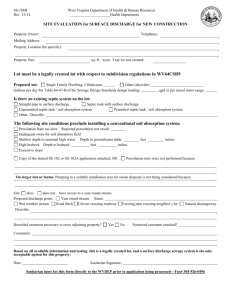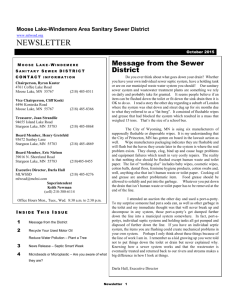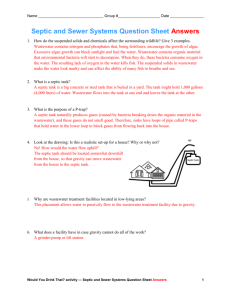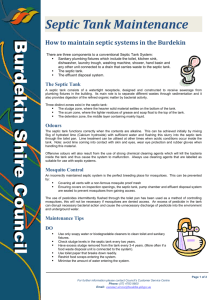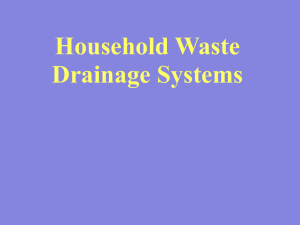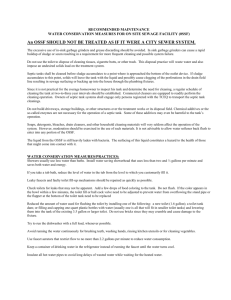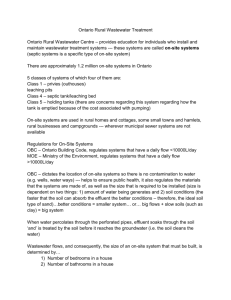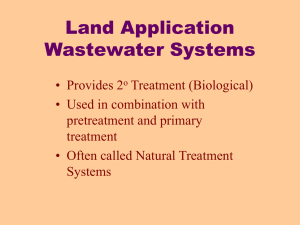newsletter
advertisement
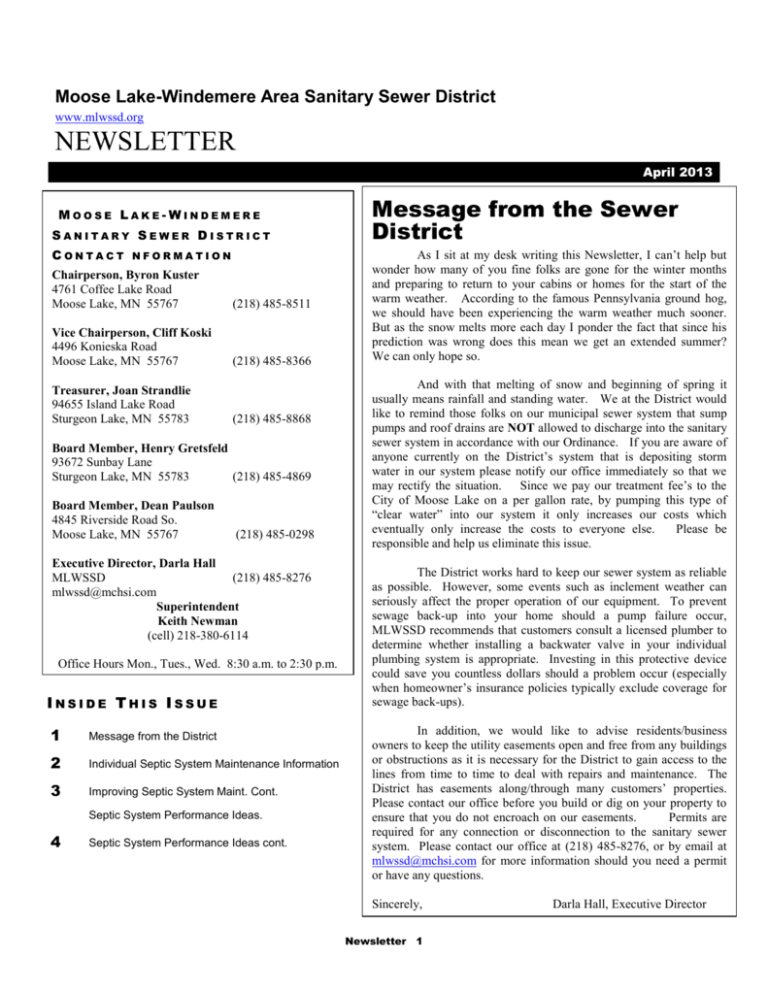
Moose Lake-Windemere Area Sanitary Sewer District www.mlwssd.org NEWSLETTER April 2013 MOOSE LAKE-WINDEMERE SANITARY SEWER DISTRICT CONTACT NFORMATION Chairperson, Byron Kuster 4761 Coffee Lake Road Moose Lake, MN 55767 (218) 485-8511 Vice Chairperson, Cliff Koski 4496 Konieska Road Moose Lake, MN 55767 (218) 485-8366 Treasurer, Joan Strandlie 94655 Island Lake Road Sturgeon Lake, MN 55783 (218) 485-8868 Board Member, Henry Gretsfeld 93672 Sunbay Lane Sturgeon Lake, MN 55783 (218) 485-4869 Board Member, Dean Paulson 4845 Riverside Road So. Moose Lake, MN 55767 (218) 485-0298 Executive Director, Darla Hall MLWSSD (218) 485-8276 mlwssd@mchsi.com Superintendent Keith Newman (cell) 218-380-6114 Office Hours Mon., Tues., Wed. 8:30 a.m. to 2:30 p.m. INSIDE THIS ISSUE 1 Message from the District 2 Individual Septic System Maintenance Information 3 Improving Septic System Maint. Cont. Septic System Performance Ideas. 4 Septic System Performance Ideas cont. Message from the Sewer District As I sit at my desk writing this Newsletter, I can’t help but wonder how many of you fine folks are gone for the winter months and preparing to return to your cabins or homes for the start of the warm weather. According to the famous Pennsylvania ground hog, we should have been experiencing the warm weather much sooner. But as the snow melts more each day I ponder the fact that since his prediction was wrong does this mean we get an extended summer? We can only hope so. And with that melting of snow and beginning of spring it usually means rainfall and standing water. We at the District would like to remind those folks on our municipal sewer system that sump pumps and roof drains are NOT allowed to discharge into the sanitary sewer system in accordance with our Ordinance. If you are aware of anyone currently on the District’s system that is depositing storm water in our system please notify our office immediately so that we may rectify the situation. Since we pay our treatment fee’s to the City of Moose Lake on a per gallon rate, by pumping this type of “clear water” into our system it only increases our costs which eventually only increase the costs to everyone else. Please be responsible and help us eliminate this issue. The District works hard to keep our sewer system as reliable as possible. However, some events such as inclement weather can seriously affect the proper operation of our equipment. To prevent sewage back-up into your home should a pump failure occur, MLWSSD recommends that customers consult a licensed plumber to determine whether installing a backwater valve in your individual plumbing system is appropriate. Investing in this protective device could save you countless dollars should a problem occur (especially when homeowner’s insurance policies typically exclude coverage for sewage back-ups). In addition, we would like to advise residents/business owners to keep the utility easements open and free from any buildings or obstructions as it is necessary for the District to gain access to the lines from time to time to deal with repairs and maintenance. The District has easements along/through many customers’ properties. Please contact our office before you build or dig on your property to ensure that you do not encroach on our easements. Permits are required for any connection or disconnection to the sanitary sewer system. Please contact our office at (218) 485-8276, or by email at mlwssd@mchsi.com for more information should you need a permit or have any questions. Sincerely, Newsletter 1 Darla Hall, Executive Director INDIVIDUAL SEPTIC SYSTEMS MAINTENANCE INFORMATION WHO HAS A SEPTIC SYSTEM? Many residents in Moose Lake Township and Windemere Township use some form of sewage treatment method other than a municipal sewer system. This “other method” of treatment is called an Onsite (or sometimes subsurface) Sewage Treatment System (or SSTS). If designed and installed properly, an SSTS can be a cost effective and environmentally safe method of treating wastewater generated within the home. WHY DOES SEWAGE NEED TO BE “TREATED” ANYWAY? Sewage contains bacteria, viruses, nutrients, some chemicals, and a small amount of heavy metals. These contaminants must be treated before they reach the groundwater, in order to prevent the spread of disease and environmental contamination. An SSTS can provide a high degree of treatment if the system is properly designed, constructed, and maintained. An SSTS treats sewage by using biological, physical, and chemical processes. WHAT IS A SEPTIC SYSTEM? A standard septic system is generally made-up of two parts: a septic tank and a septic drain field (or soil treatment system). The soil treatment system usually consists of either an in-ground system (trench system) or an aboveground system (mound system). An SSTS professional can determine which type of soil treatment system is needed, simply by analyzing your local soil conditions and determining the depth to the seasonally saturated soil (water table). HOW DOES THE SEPTIC TANK WORK? All wastewater containing human wastes, nutrients, dirt and other contaminants must be collected and delivered to the septic tank for primary treatment. Bacteria which occur naturally within the waste will begin breaking down the organic materials in the sewage. The wastewater remains in the tank for about 36 hours, which provides enough time for the sewage to settle into three layers. The floating scum layer, which forms near the top of the tank, consists primarily of soaps, greases and toilet paper. The sludge layer contains the heavy organic and inorganic material that settles to the bottom of the tank. The liquid layer, which forms between the scum and sludge layers, consists of water, liquids, and some suspended solids. It is this liquid layer that is allowed to exit the tank to next be treated by the soil treatment system. By settling and capturing all of the solids and preventing them from entering the soil-treatment system, your septic tank will help to extend the life of your drain field. To help prevent unwanted materials from leaving the tank, baffles are placed over the inlet and outlet pipes. These baffles stop any floating materials from entering the soil treatment system. If Newsletter 2 either floating scum or sludge is allowed to enter the soil treatment system, the effective life of the system can be greatly reduced. This will likely lead to the occurrence of expensive repairs! Solids can enter your soil treatment system if a large amount of water is used in a short period of time. This can occur, for example, if you wash seven loads of laundry in one day rather than washing one load each day of the week. Large quantities of water entering the tank may agitate the existing solids layer, and increase the risk of solids entering the soil treatment system. As the suspended particles are flushed into the soil treatment system by the excess water, those particles can plug pipes or soil pores and slow the rate at which the soil is able to accept wastewater for the final treatment phase. The addition of a garbage disposal in your home without also enlarging your septic tank capacity can introduce more problems for your soil treatment system. The food particles from a garbage disposal tend to be very small, and thus remain suspended longer in the liquid layer within your septic tank. This increases the likelihood that they will flow out into the soil treatment system, again causing premature failure of your soil treatment system. Adequate pumping of your septic tank will help to reduce the chances of that occurring. HOW OFTEN SHOULD YOU CLEAN YOUR TANK? Your septic tank should be cleaned (maintained), by a licensed SSTS Maintainer, approximately every two to three years, with the exact frequency depending upon levels of use. The licensed maintainer that you choose will inspect your tank to determine if it needs to be pumped. If pumping is required, they will then remove all of the scum and sludge that have accumulated in your tank. The cleaning of your tank must be performed through the 24-inch tank maintenance hole rather than through one of the 4-inch inspection pipes. As a homeowner, you should make certain that this is the case. Failure to utilize the larger and more centrally located maintenance hole will result in your tank being only partially emptied. This will increase the chances of the remaining solids floating out of your tank as it begins to refill, and finding their way into your soil treatment system where they can damage and shorten the life of your drain field. CAUTION Avoid entering your septic tank. Individuals have died from gas asphyxiation. Never permit heavy equipment to pass over the absorption field. Never smoke near septic tank openings. SEPTIC SYSTEM PERFORMANCE IDEAS Detergents, kitchen wastes, laundry wastes and household chemicals in normal amounts do not affect the proper operation of household sewage treatment systems. However, excessive quantities can be harmful. Avoid the disposal of cigarette butts, disposable diapers, sanitary napkins, plastics, trash, etc., into your household sewage system. These items are not readily decomposed. Septic tank additives are not recommended. Additives are unnecessary to the proper operation of household systems and may cause the sludge and scum in the septic tank to be discharged into the absorption field, resulting in premature failure. Some additives may actually pollute groundwater. Garbage grinders substantially increase the accumulation of solids in the septic tank, as well as the solids entering the absorption fields and pits. Their disadvantages outweigh the convenience they provide and are not recommended for households with their own sewage treatment systems. If used, the septic tank size should be increased. Newsletter 3 Do not use antibacterial soaps and cleaners and limit the use of bleach based cleaners and detergents. Do not use every flush toilet bowl disinfectants. They introduce chemicals each time you flush. Install low-flow showerheads and low-flush toilets. Use bath oils, soaps, shaving creams and other products sparingly. Shut off water while shaving and brushing teeth. Choose quick showers that use less water than tub baths. Do not flush unused medications. Use highly biodegradable dish washing detergents and purchase those with zero phosphorus content. Choose a water saving dishwasher and scrape dishes well before placing in the dishwasher. Many no scraping needed dishwashers have a built in garbage disposal which only increase solids in the septic tank. Compost kitchen waste or throw it in the garbage. Do not send meat, fat, oil, coffee grounds, and other indigested food products down the drain. Recharge your water softener as infrequently as possible. If replacing, look for an on-demand unit so the system recharges only as needed, based on the volume of water used. Be sure sump pumps, floor drains, garage drains, roof drains, and other methods of routing water away from your house are not going into the septic system. This high volume of water can easily overload the system. Keep a pitcher of drinking water in the refrigerator instead of running the tap to get cool water. If you have a drinking water treatment device, be sure there is a shut off valve on the device so the system does not run continuously when the reservoir is full. MLWSSD Moose Lake – Windemere Sanitary Sewer District 304 ½ Elm Avenue PO Box 588 Moose Lake, MN 55767 THIRD CLASS US POSTAGE PAID MOOSE LAKE, MN 55767 PERMIT NO. #73 Newsletter 4 Newsletter 5 Moose Lake-Windemere 6
